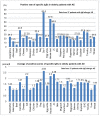Clinical Characteristics, Treatments, and Prognosis of Atopic Eczema in the Elderly
- PMID: 26239460
- PMCID: PMC4470211
- DOI: 10.3390/jcm4050979
Clinical Characteristics, Treatments, and Prognosis of Atopic Eczema in the Elderly
Abstract
Atopic eczema (AE) in the elderly is gradually increasing and has been added to the classification of AE in recent years. This investigation retrospectively analyzed 60 patients with elderly AE. Among the clinical characteristics, a male predominance, existence of several patterns of onset and clinical course, and associations with immunoglobulin (Ig)E-allergic-status and asthmatic complication were observed. The highest positive-rate and positive-score for serum-specific IgE against Dermatophagoides farinae were 83.8% and 2.65 in patients with IgE-allergic AE, and a lower incidence of lichenified eczema in the elbow and knee folds were observed. In terms of treatments and outcomes, clinical improvement and clinical remission were observed in 80.8% and 36.5% of cases, respectively, using standard treatments and combined therapy with oral corticosteroid in severe cases. As for complications and final prognosis, most elderly AE patients reached the end of life with AE, but patients with IgE-allergic AE showed significantly lower incidences of complications of malignancy and death from malignancy. These results indicate that AE in the elderly represents a new subgroup of AE with specific features.
Keywords: atopic eczema; clinical characteristics; complications; elderly; immunoglobulin E; onset; outcomes; prognosis; skin manifestations; treatment.
Figures








References
LinkOut - more resources
Full Text Sources
Other Literature Sources
Research Materials

